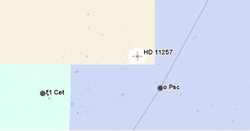Astronomy:54 Ceti
| Observation data Equinox J2000.0]] (ICRS) | |
|---|---|
| Constellation | Aries |
| Right ascension | 01h 50m 51.97256s[1] |
| Declination | +11° 02′ 36.1621″[1] |
| Apparent magnitude (V) | 5.94[2] |
| Characteristics | |
| Spectral type | F2 Vw[3] |
| U−B color index | –0.03[2] |
| B−V color index | +0.30[2] |
| R−I color index | 0.17 |
| Astrometry | |
| Radial velocity (Rv) | +11.1[4] km/s |
| Proper motion (μ) | RA: –69.464[1] mas/yr Dec.: –27.522[1] mas/yr |
| Parallax (π) | 23.7942 ± 0.1026[1] mas |
| Distance | 137.1 ± 0.6 ly (42.0 ± 0.2 pc) |
| Absolute magnitude (MV) | 2.80[5] |
| Details | |
| Mass | 1.48[6] M☉ |
| Radius | 1.62+0.08 −0.05[1] R☉ |
| Luminosity | 6.01±0.03[1] L☉ |
| Surface gravity (log g) | 4.50[3] cgs |
| Temperature | 7,099[3] K |
| Metallicity [Fe/H] | –0.20[3] dex |
| Rotational velocity (v sin i) | 29[7] km/s |
| Age | 582[6] Myr |
| Other designations | |
| Database references | |
| SIMBAD | data |
54 Ceti is an older Flamsteed designation[9] for a star that is now located within the constellation boundaries of Aries,[10] the Ram. In the present day it is known by star catalogue identifiers like HD 11257 or HR 534.[8] At an apparent visual magnitude of 5.94,[2] it can be seen with the naked eye. The distance to this star, as determined using parallax measurements made during the Hipparcos mission, is approximately 139 light-years (43 parsecs), give or take a 6 light-year margin of error.[11] It is located near the ecliptic and hence is subject to occasional occultation by the Moon.[12]
This is an F-type main sequence star with a stellar classification of F2 Vw,[3] where the 'w' indicates weak absorption lines in the spectrum. The star is around 582[6] million years old with a projected rotational velocity of 29 km/s.[7] It has 1.5[6] times the mass of the Sun and 1.6[1] times the Sun's radius. The star is radiating six[1] times the luminosity of the Sun from its photosphere at an effective temperature of 7,099 K.[3] It is a candidate member of the Ursa Major Moving Group, which has an estimated age of 500 ± 100 million years.[13]
References
- ↑ 1.0 1.1 1.2 1.3 1.4 1.5 1.6 1.7 1.8 Brown, A. G. A. (August 2018). "Gaia Data Release 2: Summary of the contents and survey properties". Astronomy & Astrophysics 616: A1. doi:10.1051/0004-6361/201833051. Bibcode: 2018A&A...616A...1G. Gaia DR2 record for this source at VizieR.
- ↑ 2.0 2.1 2.2 2.3 Johnson, H. L. et al. (1966). "UBVRIJKL photometry of the bright stars". Communications of the Lunar and Planetary Laboratory 4 (99): 99. Bibcode: 1966CoLPL...4...99J.
- ↑ 3.0 3.1 3.2 3.3 3.4 3.5 Cenarro, A. J. et al. (January 2007), "Medium-resolution Isaac Newton Telescope library of empirical spectra - II. The stellar atmospheric parameters", Monthly Notices of the Royal Astronomical Society 374 (2): 664–690, doi:10.1111/j.1365-2966.2006.11196.x, Bibcode: 2007MNRAS.374..664C.
- ↑ Wilson, Ralph Elmer (1953), "General Catalogue of Stellar Radial Velocities", Carnegie Institute Washington D.C. Publication (Washington: Carnegie Institution of Washington), Bibcode: 1953GCRV..C......0W.
- ↑ Anderson, E.; Francis, Ch. (2012), "XHIP: An extended hipparcos compilation", Astronomy Letters 38 (5): 331, doi:10.1134/S1063773712050015, Bibcode: 2012AstL...38..331A.
- ↑ 6.0 6.1 6.2 6.3 David, Trevor J.; Hillenbrand, Lynne A. (2015), "The Ages of Early-Type Stars: Strömgren Photometric Methods Calibrated, Validated, Tested, and Applied to Hosts and Prospective Hosts of Directly Imaged Exoplanets", The Astrophysical Journal 804 (2): 146, doi:10.1088/0004-637X/804/2/146, Bibcode: 2015ApJ...804..146D.
- ↑ 7.0 7.1 Royer, F.; Zorec, J.; Gómez, A. E. (February 2007), "Rotational velocities of A-type stars. III. Velocity distributions", Astronomy and Astrophysics 463 (2): 671–682, doi:10.1051/0004-6361:20065224, Bibcode: 2007A&A...463..671R.
- ↑ 8.0 8.1 "54 Cet". SIMBAD. Centre de données astronomiques de Strasbourg. http://simbad.u-strasbg.fr/simbad/sim-basic?Ident=54+Cet.
- ↑ Hoffleit, Dorrit (1964), Catalogue of bright stars (3rd revised ed.), New Haven, Conn.: Yale University Observatory, Bibcode: 1964cbs..book.....H. See the Online Data entry for HR 534.
- ↑ Hoffleit, D. (July 1979), "Discordances in star designations", Bulletin d'Information du Centre de Données Stellaires 17 (17): 38, Bibcode: 1979BICDS..17...38H.
- ↑ van Leeuwen, F. (November 2007), "Validation of the new Hipparcos reduction", Astronomy and Astrophysics 474 (2): 653–664, doi:10.1051/0004-6361:20078357, Bibcode: 2007A&A...474..653V.
- ↑ Richichi, A. et al. (January 2006), "The Calar Alto lunar occultation program: update and new results", Astronomy and Astrophysics 445 (3): 1081–1088, doi:10.1051/0004-6361:20053901, Bibcode: 2006A&A...445.1081R.
- ↑ Monier, R. (November 2005), "Abundances of a sample of A and F-type dwarf members of the Ursa Major Group", Astronomy and Astrophysics 442 (2): 563–566, doi:10.1051/0004-6361:20053222, Bibcode: 2005A&A...442..563M.
External links
 |


